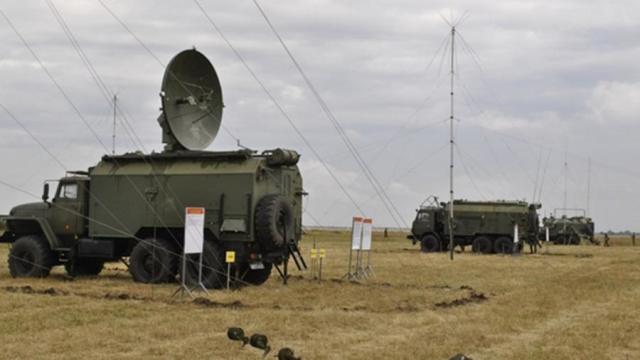The Urals and Siberia will close the field of electronic interference. The latest Polye-21 systems are deployed in the Urals and Siberia. They will become a barrier to satellite navigation systems, and will also prevent drone flights, cruise missile strikes and other high-precision weapons. The system is able not only to drown out signals from satellites, but also to introduce distortions in them, forming false coordinates. According to experts, the new product will radically strengthen the protection of Russian territory.
The Urals and Siberia will close the field of electronic interference. The latest Polye-21 systems are deployed in the Urals and Siberia. They will become a barrier to satellite navigation systems, and will also prevent drone flights, cruise missile strikes and other high-precision weapons. The system is able not only to drown out signals from satellites, but also to introduce distortions in them, forming false coordinates. According to experts, the new product will radically strengthen the protection of Russian territory.
The dome over Siberia
This year, the group of electronic suppression systems "Field-21" deployed in the Urals and Siberia, told "Izvestia" sources in the Ministry of Defense.
Last year, the head of the electronic warfare forces (EW), Lieutenant General Yuri Lastochkin, explained that modern systems allow you to disrupt the high-precision navigation of guided weapons carriers and reduce the likelihood of hitting critical industrial and defense infrastructure of our country.
"Field-21" refers to this type of weapons. But unlike conventional electronic warfare systems, it is distributed. It uses not one or more machines, but up to a hundred interference transmitters spaced at a great distance from each other. Each of them can be controlled remotely, activated and deactivated if necessary. This allows you to cover a vast area of hundreds of square kilometers with dense interference.
Tactical and technical characteristics of the complex "Field-21" were not disclosed. But, according to open publications, the export version of the station suppresses all three major foreign satellite navigation systems: the American Navstar (better known by the designation GPS), the European Galileo and the Chinese BeiDou. The area of the interference area of one complex can reach 150 by 150 km. Just one station is enough to suppress conventional GPS receivers at a distance of up to 25 km. Now they are used not only in smartphones, but also in commercial and military drones, as well as in high-precision weapons.
"Polye-21 simultaneously includes means of radio-electronic reconnaissance and radio-electronic suppression of satellite navigation systems, "military expert Viktor Murakhovsky told Izvestia. - The capabilities of the system make it possible to prevent the use of many types of high-precision weapons, including foreign-made drones. Moreover, it can not only suppress the signals of satellite navigation systems, but also make geolocation errors. This is a geographically distributed system that can increase its capabilities and cover significant areas of terrain. The complex should be used in close cooperation with air defense and missile defense systems.
In the inaccessible zone
The first production model of the "Polya-21" was taken into service in 2016. The Ministry of Defense reports that such systems have already been sent to several EW units in the Eastern Military District (VVO) and to the 201st Russian military base located in Tajikistan.
The press service of the Defense Ministry informed about the receipt last year in the VVO of the already modernized model of the "Field-21M", but did not disclose details about the changes made to it.
— In the Soviet era, EW units were in many formations and associations of the air defense forces,-said the former head of the anti-aircraft missile forces of the Air Force Alexander Gorkov. — After the mass reduction of the army, the forces and means of electronic warfare were reduced to a minimum. Since the 1990s, we have found ourselves in a situation where entire areas were uncovered. Using them, the enemy can act selectively and change the route, bypassing the fire zones of anti-aircraft missile troops and overcoming fighter aviation cover. And the creation of electronic counteraction bands with the help of the "Field-21" is extremely important. They can violate the order of use of air attack means of both manned and unmanned aircraft.
As previously reported by Izvestia, the developer company has patented the possibility of installing interference transmission stations R-340RP on cell towers. This makes it possible to provide them with a permanent source of electricity and a backup control channel, as well as to form a geographically distributed radio detection and suppression system.
In combat and in training
The Russian military has already had to use modern electronic warfare systems in combat conditions. In January 2018, they were used to repel a group raid by improvised unmanned extremist bombers on the Hmeimim and Tartus bases in Syria. Of the 13 drones of the militants, seven were shot down by air defense fire. The rest were forced to land by EW specialists. The wreckage and captured intact drones were shown to Russian and foreign media. In the following years, the militants repeated attacks on Russian bases dozens of times, but all of them were unsuccessful.
To suppress drones, the complex is often used in combination with other modern electronic warfare equipment of the Russian army: "Snare", "Resident", "Lesochek", "Borisoglebsk-2".
Last year, the Central Military District practiced creating a continuous controlled interference field for satellite navigation. With the help of the new system, they covered the regrouping of the district's troops and the beginning of the combat operation.
According to the Russian Ministry of Defense, from 2012 to 2020, more than two dozen modern electronic warfare equipment samples were accepted for supply. From the use of traditional "jammers", it was possible to move to innovative methods of signal suppression and distortion. In addition to the "Field-21", they include the"Leer-3" complex. It has interference transmitters for cellular signals installed on small Orlan-10 drones. They are also able to determine the coordinates of cell phones within a radius of several kilometers and send mass SMS messages to them.

